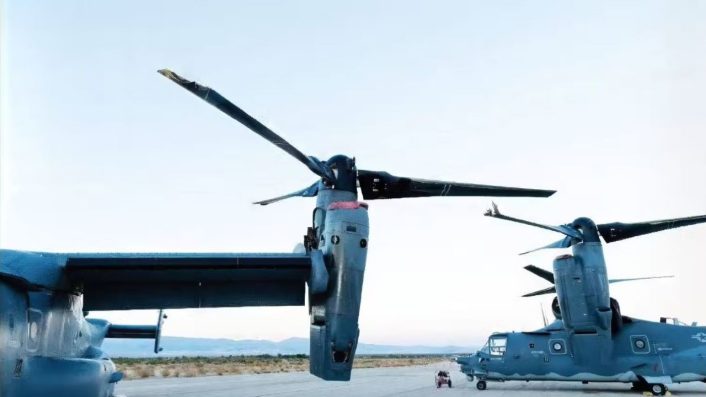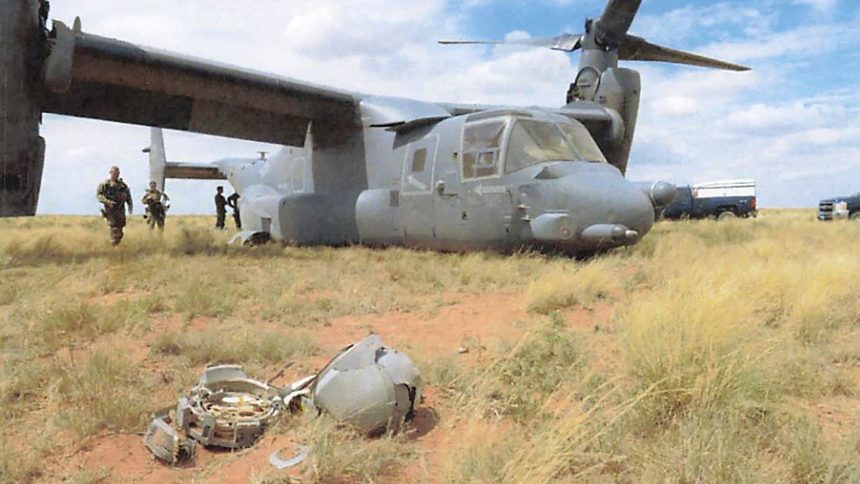The incidents took place on Aug. 17 and Aug. 22, 2023 at Inyokern, California, and the Melrose Air Force Range, New Mexico, respectively. Fortunately, the did not result in any fatalities.
Two separate mishaps involving two U.S. Air Force CV-22B Ospreys in Aug. 2023 were found to have been a result of human error AIB (Accident Investigation Board) reports have found.
The incidents in question, which fortunately did not result in any fatalities, took place on Aug. 17 and Aug. 22, 2023 at Inyokern, Naval Air Weapons Station China Lake, California, and the Melrose Air Force Range in New Mexico, respectively.
Inyokern
At Inyokern, on Aug. 17, 2023, the co-pilot of the CV-22 (tail number 08-000039) maneuvered too close to another CV-22 (09-000046) nearby, causing the rotors of the two planes to collide. The aircraft, part of the 27th SOW (Special Operations Wing)/20th SOS (Special Operations Squadron) at Cannon AFB, had deployed to Inyokern Airport and conducting defensive systems training at China Lake. The CV-22s were parked on an apron at one end of Inyokern’s runway with sufficient space for four aircraft.
However, ground crew reported the apron’s physical deterioration, causing loose concrete and dirt blowing into them by the CV-22’s rotors. “While clearing the runway and proceeding to the parking ramp, the MCP (Mishap Co-Pilot) announced a deviation to the right side of the taxiway to avoid a large hole in the concrete,” said the report. After landing, the MCP “executed a left-hand turn to position the aircraft for reverse taxi into park.” The MCP announced the left turn prior to initiating it.
But the MP (Mishap Pilot), despite responding with ‘roger’, never confirmed that the aircraft was clear of the adjacent aircraft. “The MP also remembered feeling ‘uncomfortable’ during the execution of this maneuver.” The two aircraft’s proprotors eventually collided. The debris flew toward a ground crew member who hit his head while diving for cover to dodge the blade, and sustained a concussion.
The lose concrete and dust hitting maintenance members meanwhile forced them to not assign a ‘Front Marshaller’ before the CV-22, “restricting visibility and decreasing their ability to provide marshaling instructions.”
“Approximately halfway through the deployment, the front marshaller position was abandoned due to the hazards associated with marshaling aircraft. Neither the hazards nor the subsequent change to taxiing without a front marshaller were communicated to the Mission Commander or the flight crews.”
The ground crew also did not use standardized language, communication and signaling equipment, including “daytime fluorescent wands,” which are recognized by the Air Force Manual. “The only aircraft marshal signaling devices available were battery operated green, red or light sticks.” The blades of both aircraft were meanwhile damaged “beyond repairable limits,” costing $2.5 million.

To sum up, while the copilot failed to ensure sufficient clearance before commencing to park, the aircraft commander failed to tell the copilot to stop, despite feeling “uncomfortable” with the close distance between the two aircraft. Mission planners failed to mention potential hazards like “congested aircraft parking area, non- standard reverse taxi requirements, deteriorating concrete conditions, and lack of ramp illumination.” A “false sense of security,” “inappropriate decision-making,” contributed to “inattention to hazards” and “inattention to risks.”
Melrose
On Aug. 22, 2023, within a week of the accident at Inyokern in California, a CV-22B also of the the 27th SOW from Cannon AFB (Air Force Base) in New Mexico slammed to the ground upright at the Melrose Air Force Range. This is when the flight engineer’s NVG (Night Vision Goggle) battery pack cable got looped around a lever that accidentally switched off an engine. The aircraft sustained damage worth $2 million.
This is what a summary of the report said:
“The AIB president found the cause of the mishap by a preponderance of the evidence was a flight engineer unintentionally and unknowingly shut down the right engine when their night vision goggles battery cable looped over the knob of the right engine control lever and moved it from the FLY to OFF position while attempting to sit down in the flight engineer seat.
Additionally, the AIB President found by a preponderance of the evidence the following factors: (1) the mishap aircraft commander failed to guard the engine control levers, (2) inattention of the aircrew during a critical phase of flight, (3) failure of real-time risk assessment, and (4) a lack of procedural guidance.”
The Osprey had been hovering about 190 feet above the ground, and the pilots were preparing for forward flight and retracted the landing gear. The flight engineer then entered the cockpit “with significant slack” in his night vision goggle battery pack cable. While sitting in his designated seat, his NVG battery cable anchored around the right engine control lever and turned it off.
The aircraft thus began plunging toward the ground at up to 1,500 feet per minute, with the single engine not being able to generate enough lift. The aircraft commander was able to pull the nose up to arrest the aircraft’s forward speed and slow the descent rate to 800 feet per minute, but in just 11 seconds the Osprey struck the ground at a speed of around 40 knots. When the aircraft bounced, the looped battery pack cable again turned on the engine lever to “FLY,” causing the Osprey to slide about 360 feet.
The crash damaged the “antennae, lights, nose landing gear doors, and the Forward-Looking Infrared (FLIR) turret”, costing little more than $2 million.
Previous accidents
The investigation reports on the August 2023 mishaps highlight how, within five days, members of the 20th Special Operations Squadron at Cannon Air Force Base, were involved in incidents that caused damages in excess of $4.5 million. Neither crash was deemed a systemic issue, alleviating concerns over the Osprey, which has faced scrutiny after several deadly accidents in recent years.
The latest one, on Nov. 29, 2023, off the coast of Japan, killed eight personne and took place because of a “catastrophic failure” concerning the PRGB (Prop Rotor Gear Box). Following the accident, U.S. military authorities ordered a fleet-wide safety stand down of the 400 Ospreys: besides the those in service with the U.S. military (MV-22B of the USMC; CMV-22 carrier onboard delivery logistics aircraft of the U.S. Navy flies; and CV-22B of U.S. Air Force) also the Japanese V-22s.
“Restricted” operations resumed in March 2024, with the primary stipulation being a maximum flight duration of 30 minutes and only around a suitable airfield.
Other measures required the crew to gain “proficiency” with fresh maintenance, repair and piloting procedures before a “gradual” and “phased” resumption to full operations.
The aircraft has subsequently appeared frequently in exercises like the recent RIMPAC (Rim of the Pacific) 2024 and the landing on the Turkish amphibious assault carrier, TCG Anadolu, possibly flying under these limits.
7月30日、#レゾリュート・ドラゴン24 に参加中の #ヘリ団 #輸送航空隊 V-22
は、米海兵隊のMV-22との共同編隊飛行を実施するとともに、米海兵隊岩国基地において
燃料補給を実施して、日米共同に係る実効性向上を図りました。#V22 pic.twitter.com/kDMb6ZOGHb
— 第1ヘリコプター団/木更津駐屯地 (@1st_helb) August 2, 2024









